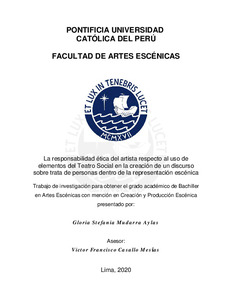| dc.contributor.advisor | Casallo Mesías, Víctor Francisco | |
| dc.contributor.author | Mudarra Aylas, Gloria Stefania | |
| dc.date.accessioned | 2022-10-07T21:13:49Z | |
| dc.date.available | 2022-10-07T21:13:49Z | |
| dc.date.created | 2020 | |
| dc.date.issued | 2022-10-07 | |
| dc.identifier.uri | http://hdl.handle.net/20.500.12404/23486 | |
| dc.description.abstract | El presente artículo expone la perspectiva ética del proceso creativo en los artistas
escénicos al momento de utilizar un discurso sobre trata de personas en el Perú. El artista
toma la responsabilidad de hacer escuchar las voces de muchas víctimas, las cuales quieren
expresar una denuncia o intentar comunicarse a través del teatro. No obstante, se presta a
la siguiente pregunta: ¿Qué responsabilidades éticas tiene el artista al momento de a aportar
a la creación de un discurso sobre la trata de personas dentro de la representación escénica?
Se expone que se debe tener en cuenta la importancia de investigar el contexto del otro al
momento de representarlo para no posicionarlo en una población vulnerable.
Asimismo, se analiza los problemas éticos que pueden presentarse durante el
proceso creativo, ya que se puede dar un enfoque distinto por las diversas posturas sobre
este tema. Por ejemplo, el proteger a la víctima dando un discurso que tenga
responsabilidad ética de representación permite un espacio para reflexionar sobre eso. Se
utiliza diversos conceptos éticos de autores que proponen formas de juzgar mediante
conceptos éticos para un adecuado discurso. De ese modo, se muestra que respetando la
autonomía del otro se puede usar elementos del Teatro Social, las cuales pueden aportar a
los artistas escénicos a llevar un adecuado discurso sobre ese problema social. Sin embargo,
se puede apreciar que el proceso de creación del discurso y representación del otro es un
ejercicio complejo que puede prestarse a diferentes entendimientos. | es_ES |
| dc.description.abstract | This article presents the ethical perspective of the creative process in performing
artists when using a discourse on human trafficking in Peru. The artist takes the
responsibility of making the voices of many victims heard, who want to express a
complaint or try to communicate through the theater. However, it lends itself to the
following question: What ethical responsibilities does the artist have when contributing to
the creation of a discourse on human trafficking within the stage performance? It is stated
that the importance of investigating the context of the other must be taken into account
when representing them so as not to position them in a vulnerable population.
Likewise, the ethical problems that may arise during the creative process are
analyzed, since a different approach can be given by the different positions on this subject.
For example, protecting the victim by giving a speech that has the ethical responsibility of
representation allows a space to reflect on that. Various ethical concepts of authors are used
that propose ways of judging through ethical concepts for an adequate discourse. In this
way, it is shown that while respecting the autonomy of the other, elements of the Social
Theater can be used, which can contribute to the performing artists to carry an adequate
discourse on this social problem. However, it can be seen that the process of creating the
discourse and representing the other is a complex exercise that can lend itself to different
understandings. | es_ES |
| dc.language.iso | spa | es_ES |
| dc.publisher | Pontificia Universidad Católica del Perú | es_ES |
| dc.rights | info:eu-repo/semantics/openAccess | es_ES |
| dc.rights.uri | http://creativecommons.org/licenses/by-sa/2.5/pe/ | * |
| dc.subject | Ética--Estudio y enseñanza | es_ES |
| dc.subject | Teatro | es_ES |
| dc.subject | Teatro y sociedad | es_ES |
| dc.title | La responsabilidad ética del artista respecto al uso de elementos del Teatro Social en la creación de un discurso sobre trata de personas dentro de la representación escénica | es_ES |
| dc.type | info:eu-repo/semantics/bachelorThesis | es_ES |
| thesis.degree.name | Bachiller en Artes Escénicas con mención en Creación y Producción Escénica | es_ES |
| thesis.degree.level | Bachillerato | es_ES |
| thesis.degree.grantor | Pontificia Universidad Católica del Perú. Facultad de Artes Escénicas | es_ES |
| thesis.degree.discipline | Artes Escénicas con mención en Creación y Producción Escénica | es_ES |
| renati.advisor.dni | 07618700 | |
| renati.advisor.orcid | https://orcid.org/0000-0001-7954-5780 | es_ES |
| renati.author.dni | 72374101 | |
| renati.discipline | 215096 | es_ES |
| renati.level | https://purl.org/pe-repo/renati/level#bachiller | es_ES |
| renati.type | https://purl.org/pe-repo/renati/type#trabajoDeInvestigacion | es_ES |
| dc.publisher.country | PE | es_ES |
| dc.subject.ocde | https://purl.org/pe-repo/ocde/ford#6.04.04 | es_ES |






